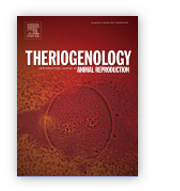Genetic basis of sow hyperprolificacy and litter size optimization based on a genome-wide association study
Błażej Nowak; Anna Mucha; Magdalena Zatoń-Dobrowolska; Grzegorz Chrostowski; Wojciech Kruszyński
Theriogenology
Ministerial score = 140.0
Journal Impact Factor (2023) = 2.8 (Q1)
 Over the last few decades, there has been a constant increase in sow litter size, the consequences of which include parturition duration extension, an increase in the percentage of stillborn and hypoxic piglets, and increased variation in piglet birth weight, which reduces their vitality. As such, it seems clear that further increasing sow fertility will generate difficulties and costs in rearing numerous litters with low birth weights. Therefore, the current study aimed to analyze the genetic background of sow hyperprolifcacy using a genome-wide association study (GWAS). The research included 144 sows in the maternal component, divided into two equal groups. The first group (control) consisted of females giving birth to the optimal number of piglets in their third and fourth litters (14–16), while the second group (cases) included those with excessive litter size (>16). The analyzed sows were genotyped using Illumina's PorcineSNP60v2 BeadChip microarray, comprising 64,232 single nucleotide polymorphisms (SNPs). Statistical analysis using R included quality control of genotyping data and GWAS analysis based on five logistic regression models (dominant, codominant, overdominant, recessive, and log-additive) with a single SNP marker as the explanatory variable. On this basis, one SNP (SIRI0000069) was identified on chromosome seven within the EFCAB11 (EF-hand calcium binding domain 11) gene that had a statistically significant effect on sow hyperprolificacy. Additionally, ten SNPs (INRA0007631, ALGA0011600, ALGA0043433, ALGA0043428, M1GA0010535 ALGA00443338, ALGA0087116, MARC0056787, ALGA0112928, and ALGA0089047) had a relationship with the analyzed feature at a level close to significance, set at 1−5. These SNPs appear important since they are located on chromosomes on which a large number of quantitative trait loci (QTLs) and SNPs associated with reproductive characteristics, including litter size, have been identified.
Over the last few decades, there has been a constant increase in sow litter size, the consequences of which include parturition duration extension, an increase in the percentage of stillborn and hypoxic piglets, and increased variation in piglet birth weight, which reduces their vitality. As such, it seems clear that further increasing sow fertility will generate difficulties and costs in rearing numerous litters with low birth weights. Therefore, the current study aimed to analyze the genetic background of sow hyperprolifcacy using a genome-wide association study (GWAS). The research included 144 sows in the maternal component, divided into two equal groups. The first group (control) consisted of females giving birth to the optimal number of piglets in their third and fourth litters (14–16), while the second group (cases) included those with excessive litter size (>16). The analyzed sows were genotyped using Illumina's PorcineSNP60v2 BeadChip microarray, comprising 64,232 single nucleotide polymorphisms (SNPs). Statistical analysis using R included quality control of genotyping data and GWAS analysis based on five logistic regression models (dominant, codominant, overdominant, recessive, and log-additive) with a single SNP marker as the explanatory variable. On this basis, one SNP (SIRI0000069) was identified on chromosome seven within the EFCAB11 (EF-hand calcium binding domain 11) gene that had a statistically significant effect on sow hyperprolificacy. Additionally, ten SNPs (INRA0007631, ALGA0011600, ALGA0043433, ALGA0043428, M1GA0010535 ALGA00443338, ALGA0087116, MARC0056787, ALGA0112928, and ALGA0089047) had a relationship with the analyzed feature at a level close to significance, set at 1−5. These SNPs appear important since they are located on chromosomes on which a large number of quantitative trait loci (QTLs) and SNPs associated with reproductive characteristics, including litter size, have been identified.
DOI:10.1016/j.theriogenology.2024.01.035









